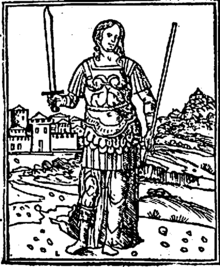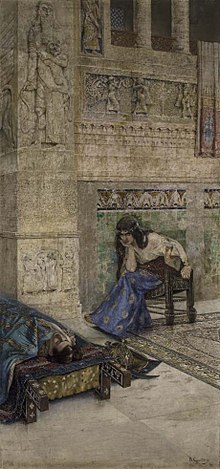Semiramis

Semiramis was a legendary Assyrian queen, also known as Semiramide, Semiramida, or Shamiram in Aramaic.
Many legends have accumulated around her personality. Various efforts have been made to identify her with real persons. She is sometimes identified with Shammuramat, the Babylonian wife of Shamshi-Adad V (ruled 811 BC–808 BC).
The legends narrated by Diodorus Siculus, Justin and others from Ctesias of Cnidus make a picture of her and her relationship to King Ninus.
The name of Semiramis came to be applied to various monuments in Western Asia, the origin of which was forgotten or unknown.[1] Ultimately every stupendous work of antiquity by the Euphrates or in Iran seems to have been ascribed to her even the Behistun Inscription of Darius.[2] Herodotus ascribes to her the banks that confined the Euphrates [3] and knows her name as borne by a gate of Babylon.[4]
Various places in Medea bore the name of Semiramis, but slightly changed, even in the Middle Ages, and an old name of Van city was Shamiramagerd.
Biography according to Diodorus Siculus

According to legend, Semiramis was of noble parents, the daughter of the fish-goddess Derketo of Ascalon in Syria and a mortal. Derketo abandoned her at birth and drowned herself. The child was fed by doves until she was found and brought up by Simmas, the royal shepherd.
Afterwards she married Onnes or Menones, one of the generals of Ninus. Ninus was so struck by her bravery at the capture of Bactra that he married her, forcing Onnes to commit suicide.
She and Ninus had a son named Ninyas. After King Ninus conquered Asia, including the Bactrians, he was fatally wounded by an arrow. Semiramis then masqueraded as her son and tricked her late husband's army into following her instructions because they thought these came from their new ruler. After Ninus's death she reigned as queen in her own right, conquering much of Asia.
Not only was she able to reign effectively, she also added Ethiopia to the empire. She restored ancient Babylon and protected it with a high brick wall that completely surrounded the city. She is also credited with inventing the chastity belt.
In the end, however, her son killed her.
The association of the fish and dove is found at Hierapolis Bambyce (Mabbog), the great temple at which, according to one legend, was founded by Semiramis [5], where her statue was shown with a golden dove on her head.[6]
Semiramis in Armenian legend

Armenian tradition portrays her as a homewrecker and a harlot. These facts are partly to be explained by observing that, according to the legends, in her birth as well as in her disappearance from earth, Semiramis appears as a goddess, the daughter of the fish-goddess Atargatis, and herself connected with the doves of Ishtar or Astartë.
One of the most popular legends in Armenian tradition involves Semiramis and an Armenian king, Ara the Beautiful. In the 20th century, the poet Nairi Zarian retold the story of Ara the Beautiful and Shamiram, considered a masterpiece of Armenian literary drama.
According to the legend, Semiramis had heard about the fame of the handsome Armenian king Ara, and she lusted after his image. She asked Ara to marry her, but he refused; upon hearing this, she gathered the armies of Assyria and marched against Armenia.
During the battle, which may have taken place in the Ararat valley, Ara was slain. In order to avoid continuous warfare with the Armenians, Semiramis, reputed to be a sorceress, took his body and prayed to the gods to raise Ara from the dead. When the Armenians advanced to avenge their leader, she disguised one of her lovers as Ara and spread the rumor that the gods had brought Ara back to life. As a result, the war ended.[7]
Although many different versions of the legend exist, it is usually accepted that Ara never came back to life.
Historicity
While Semiramis is clearly a legendary figure, she is sometimes considered a dim reflection of the historical queen Shammuramat (ruled 811-808 BC), the Babylonian wife of Shamshi-Adad V. After her husband's death, she appears to have served as regent for several years for her son, Adad-nirari III. This identification is disputed as being merely based on the similar sound of the two names.[citation needed]
In later traditions
- In The Divine Comedy, Dante sees Semiramis among the souls of the lustful in the Second Circle of Hell:
And as the cranes go chanting forth their lays,
Making in air a long line of themselves,
So saw I coming, uttering lamentations,
Shadows borne onward by the aforesaid stress.
Whereupon said I: "Master, who are those People, whom the black air so castigates?"
"The first of those, of whom intelligence Thou fain wouldst have," then said he unto me,
"The empress was of many languages. To sensual vices she was so abandoned,
That lustful she made licit in her law,
To remove the blame to which she had been led.
She is Semiramis. . .
She succeeded Ninus, and was his spouse;
She held the land which now the Sultan rules.[8][citation needed]
Semiramis appears in plays and operas, most notably Voltaire's tragedy Semiramis, Domenico Cimarosa's opera Semiramide and Gioacchino Rossini's opera, also called Semiramide.
She has also appeared in several sword and sandal films. An Italian progressive rock group named Semiramis released one album in 1973.
In literature Semiramis often stands as an icon of beauty. [citation needed]
In William Faulkner's Snopes Trilogy Eula Varner is her modern incarnation. Faulkner quite likely got the name from Inferno V where she appears in the same list as Helen of Troy as those punished for uncontrolled passion.
Protestant minister Alexander Hislop imagined Semiramis as the originator of a cosmic symbol; in his book The Two Babylons, Hislop attempted to demonstrate that Semiramis and Nimrod, are identical to Isis and Osiris, or Astarte and Tammuz.
Semiramis goes on to become the Blessed Virgin Mary according to Hislop's version of the tale; most of the world's mythical figures are retellings of the tale of Semiramis and Nimrod. This mythography is supposed to demonstrate that Roman Catholicism is in fact paganism.
Hislop's story continues to be circulated among some fundamentalist Protestants today in the form of Jack Chick tracts, comic books and related media. Minister John Hagee, in a May 2006 sermon entitled "Counterfeit Christianity: Symbolism over Substance", also seemed to accept this account.[citation needed]
Hislop's goddess hypothesis
Protestant minister Alexander Hislop in The Two Babylons (1853)[9] imagined Semiramis as an actual person in ancient Mesopotamia who single-handedly invented polytheism and, with it, goddess worship.
In this telling, Semiramis is a consort of Nimrod, builder of the Bible's Tower of Babel. (The Bible actually makes no mention of consorts of Nimrod, of Nimrod as the builder of the tower, or of the name Semiramis.)
Semiramis invents polytheism in an effort to corrupt her subjects' original faith in the god of Genesis and deify herself in their eyes.
In support of his hypothesis Hislop mentioned legends of Semiramis being raised by doves. He invoked writings by the church's Ante Nicene Fathers to suggest that these stories began as propaganda invented and circulated by Semiramis herself so her subjects would ascribe to her the status of virgin birth and view her child as the fulfilment of the "seed" prophecy in Genesis 3:15.
Hislop identified Semiramis's child as the Bible's Tammuz.
He went on to maintain that all divine pairings in world myths and religions, such as Isis/Osiris, Aphrodite/Cupid, Asherah/Orion, Mary/Jesus and others, represent retellings of this original story.
Hislop took literary references to Osiris and Orion as "seed of woman" to be evidence in support of his thesis. The legends already existing in his day about Semiramis and Ninus he viewed as distortions of history.
Notes
References
Primary sources
- Paulinus Minorita, Compendium
- Eusebius, Chronicon 20.13-17, 19-26
- Orosius, Historiae adversus paganos i.4, ii.2.5, 6.7
- Justinus, Epitome Historiarum philippicarum Pompei Trogi i.2
- Valerius Maximus, Factorum et dictorum memorabilium libri ix.3, ext 4
Secondary sources
- This article incorporates text from a publication now in the public domain: Chisholm, Hugh, ed. (1911). Encyclopædia Britannica (11th ed.). Cambridge University Press.
{{cite encyclopedia}}: Missing or empty|title=(help)
